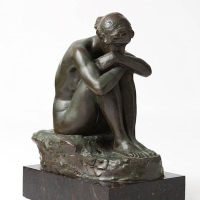63. Bertram Mackennal

The depiction of historical and contemporary women form a major component of Bertram Mackennals work. These late 19th and early 20th century sculptures were highly lauded during his life and actively sought out by Australian collectors in the 1920s after they had been shipped back from overseas. The works were also produced during a period of dramatic social upheaval in the West. At the same time as women campaigned for basic democratic freedoms, including the right to vote, the dominant image of women represented in fin de sicle art revolved around the binary conflation of females as demure and acquiescent or conversely as dangerous femme fatales.
Sappho was a Greek lyric poet who was born around 620 BC. She was so famous in her own lifetime that busts and paintings abound and even coins were minted in her honour. Bertram Mackennals Sappho c1909, presents us with a nude who is neither idealised nor threatening. She appears strong in stature and spirit. There is little garnishment. Her hair is braided and held tightly back, she is healthy without being demonstrably fecund and there are no flowing gowns or private accoutrements that one might normally expect. By tucking the figure and drawing her head towards her knees, Mackennal asks the viewer to focus on Sapphos emotional or mental state. Her physical demeanour thus expresses a person engaged in intense and introspective thought. With a sensitive touch and sound knowledge of human form, Mackennal draws upon the example of Auguste Rodin, a contemporary French sculptor who prided himself on conveying the expressive potential of the human body and face.
The representation of women in art throws up many conundrums. Strong, engaging and/or controversial women are often portrayed in ways that limit their subjectivity and agency. This attitude in turn reinforces mainstream (male) attitudes towards women and their respective position in society.
In this respect Bertram Mackennal would have been aware of the late 19th century characterisation of Sappho that linked her to overtly sexual themes, lesbianism, insatiable passion and unrequited love. In a now well-known 1877 painting by Charles Auguste Mengin, for example, Sappho is pictured as a dangerously seductive and intimidating woman who excites men but is to be ultimately feared. In Mengins painting her dangerous passion is reinforced by the abyss into which she is about to jump. Contemporaries of Mengin and Mackennal would have understood the negative connotations that the intended suicide brought, either as a metaphor for falling into a swoon or the experience of female promiscuity and sexual relief.
If Mengins painting represents the dire consequences of unfettered passion from a male perspective then Mackennals sculpture redresses this by presenting an empathetic portrait of a woman experiencing grief. Both in this bronze and the Carrara marble statuette, held in the collection of the Ashmolean Museum, University of Oxford, Mackennal conveys a believable set of emotions and gestures that Sappho endured from the loss of her companion, a young boatman named Phaon.
When the marble version was unveiled at the London Academy in 1909 visitors and art critics warmed to this sensitive portrayal of the popular love story and the virtues of simplicity and naturalism. A Ladys Letter from London, dated 7 May, cited the statuette Sappho as the most interesting of the four works on display, referring to a nude woman, sitting with head bowed in dreamy thought. Small as the work is, it has a power and individuality, the writer wrote.1 The Australasian art critic conveyed similar sentiments when he singled out the bronze Sappho in an exhibition of Mackennals sculptures held in Australia in 1928. It is an attractive work, he surmised, easy and natural in pose.2
Footnotes
1. Australasian, 12 June 1909, p.47
2. Australasian, 19 May 1920, p.20
Rodney James BA (Hons); MA